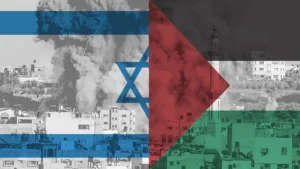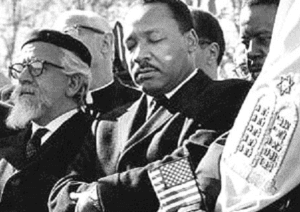By Dr. Mario D. Wallace
Throughout history, groups of people have faced oppression, violence, and forced displacement, often underpinned by political, racial, or religious motivations. The Holocaust remains one of the most infamous examples of systematic violence and genocide. Over six million Jews were killed during this dark period, their culture, families, and communities decimated. Many looked to the establishment of a Jewish state as a refuge. In the Middle East, the Israeli-Palestinian conflict has sparked a continuing cycle of violence and dispossession, with Gaza often at its epicenter. While these two situations have profound differences, parallels emerge in the shared experiences of devastation, trauma, and the relentless struggle for freedom and identity.
A Brief History: From the Holocaust to Israel’s Formation
The Holocaust’s horrors began in the 1930s, culminating in a systematic genocide in Nazi concentration camps. With six million lives lost and countless families separated or erased, Jewish communities faced a crisis of survival. The global outcry led to the establishment of Israel in 1948, envisioned as a homeland for Jewish survivors. However, the establishment was marked by the displacement of Palestinian communities, who viewed the creation of Israel as a forceful intrusion on their ancestral lands. Some historians argue that the suffering and dispossession of the Jewish people set a precedent for the recognition of the trauma and injustices Palestinians would later face.
The Formation of Israel and Palestinian Displacement
The U.N. and international powers like the United States, the Soviet Union, and Britain endorsed the partition of Palestine, but local opposition was fierce. In 1948, the Nakba, or “catastrophe,” occurred, during which hundreds of thousands of Palestinians were displaced, their villages destroyed as Israel became an established state. Gaza, specifically, became one of the most densely populated areas for displaced Palestinians. Confined to a small territory with scarce resources, Gaza’s population grew as people fled violence and sought refuge from settlements elsewhere.
Life Under Siege: Gaza and the West Bank Today
Palestinians in Gaza today face severe restrictions on movement, limited access to healthcare, clean water, and electricity, and frequent conflict flare-ups. Repeated military actions between the Israeli military and militant groups like Hamas have created a perpetual environment of fear and instability. Comparatively, during the Holocaust, Jewish communities were enclosed in ghettos, denied access to resources, and subjected to violence. Although the Holocaust and the situation in Gaza are different in nature and scope, both represent profound human rights crises resulting from displacement, racial targeting, and political agendas.
Global Political Dynamics: A Patchwork of International Interests
Many of the political factors that established Israel continue to influence the region. The United States remains one of Israel’s staunchest allies, supporting its security initiatives and economic stability, while many countries in the Middle East, as well as global powers like Russia, hold complex, sometimes contradictory, positions on Palestinian sovereignty. While U.S. administrations have occasionally pursued peace negotiations, efforts often collapse under conflicting interests, especially when Israel’s military actions receive significant funding and endorsement from the U.S.
Additionally, movements advocating for Palestinian rights, including the Boycott, Divestment, Sanctions (BDS) movement, have prompted some political and corporate backlash. In the U.S., several states have introduced legislation prohibiting BDS support, underlining how deeply woven the issue is into American politics.
Media Coverage and the Battle for Narrative Control
Media coverage of the Gaza situation, especially in Western outlets, is frequently criticized for bias. Some outlets characterize Palestinians primarily through the lens of conflict, emphasizing terrorism and violence rather than the ongoing humanitarian crisis. This contrasts with Holocaust coverage, where global media unambiguously condemned Nazi atrocities as they became known, spurring a unified sense of sympathy and urgency for action.
When individuals or media outlets take a stance supporting Palestinian rights, they often face backlash or allegations of anti-Semitism. Media regulations and corporate interests may influence narratives, leading to inconsistent reporting on Gaza. Many Palestinian journalists are censored or face limited freedom of movement, making accurate reporting from the region challenging. However, international outcry has increasingly highlighted the need for balanced coverage, with digital platforms amplifying Palestinian voices and sharing alternative perspectives.
The Quest for Freedom and the Hope for Peace
Both the Jewish and Palestinian peoples have endured profound hardships and generational traumas. The Jewish experience post-Holocaust was followed by international sympathy and efforts to restore and protect the community through the establishment of Israel. Palestinians, however, continue to struggle for recognized statehood, autonomy, and a place of safety amidst ongoing conflict. Peace in the region would demand addressing the grievances and rights of Palestinian people, affirming their identity and autonomy within an equitable, diplomatic framework.
The questions of lasting peace, recognition, and freedom for Palestinians remain open-ended. Many believe the international community must advocate for balanced approaches that value both Israeli security and Palestinian sovereignty. The promise of freedom and recognition—long denied—is the shared hope threading through both the Jewish and Palestinian historical journeys. Achieving this in Gaza requires committed, unbiased engagement from the global community and an acknowledgment of historical and ongoing injustices. Only then can a meaningful path to peace and dignity for all in the region be forged.















